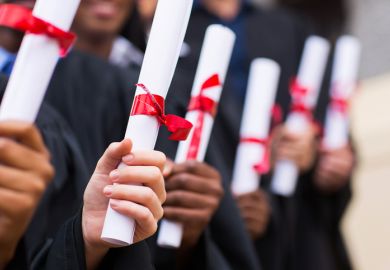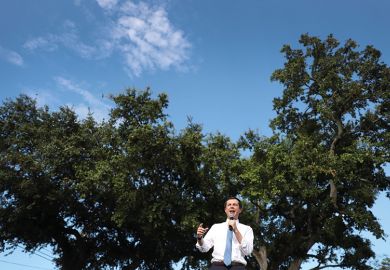America’s historically black colleges and universities (HBCUs) were crucial in the establishment of an African American middle class. The 105 that still exist continue to make a major contribution to African American success across many disciplines, especially the sciences.
It is only right that we celebrate this success. But here, as scholars who have studied and worked in collaboration with HBCUs for 33 years, we want to make a different argument. In carrying out the research for our new book, Making Black Scientists: A Call to Action (Harvard University Press), we have come to realise that the practices and approaches adopted by HBCUs to promote scientific attainment among their students have important lessons for all universities.
The first HBCUs were established in the US in 1865, shortly after the end of the Civil War. They were thus born out of segregation, at a time when most institutions systematically excluded African Americans. This makes them unlike any other universities or colleges. The only parallel is the system set up for the non-white population by the South African government under the apartheid regime in 1959. But while there were once nearly 200 HBCUs in the US, South Africa created only five, including some designed for “coloureds” and Indians as well as Africans. Now most have been merged with nearby white institutions (with the exception of the University of the Western Cape, which was established for the “coloured” population). In the US, although there have been a few mergers, and talk of a few more, the majority of HBCUs have maintained the infrastructure of their origins and remain majority African American, while today enrolling a more diverse student population.
As with their South African counterparts, American HBCUs always operated under unequal and structurally inferior conditions. Research by the two of us and others has shown that there are cases where public HBCUs are forced to operate with considerably less funding (per full-time enrolled student) than that given to counterpart predominantly white institutions (PWIs) in the same state, or where they suffer disproportionately from any cuts.
Yet their achievements are remarkable. According to the National Science Foundation, HBCUs confer nearly 15 per cent of all bachelor’s degrees (16 per cent in the sciences) awarded to black students despite making up only 3 per cent of all post-secondary institutions in the US. Xavier University of Louisiana now produces more black alumni who go on to graduate from medical schools than any other institution in the country. In fact, along with Xavier, according to the Association for American Medical Colleges, four other HBCUs – Spelman College, Morehouse University, Howard University and Florida A&M University – are ranked in the top 20 for supplying the largest numbers of black applicants to medical school. When we consider that these HBCUs enrol 2,000 to 10,000 students and are competing against much larger and better resourced institutions such as the University of Florida and the University of Texas at Austin (both with more than 50,000 students), it is clear that HBCUs are doing something right, which any university committed to diversity and creating a positive learning environment for all students should reflect on and learn from. Here we highlight four features that were common to all 10 of the institutions we studied and that contributed heavily to student achievement in the sciences.

First of all, HBCUs generally value collaboration over competition, and especially in the sciences. At most colleges and universities, the sciences are highly competitive, individualistic and built on the idea of “weeding out” students in early classes. As a result of this culture, students often see classmates as competition and don’t want to help each other. Such an atmosphere can demotivate women and people of colour, as they tend to amplify the feelings of loneliness and isolation they already experience in a sea of white men.
At HBCUs, by contrast, students are encouraged to work together and to understand how their success is tied to each other’s. They are urged to ensure that their classmates understand the material, to share notes, to work with peers who might be taking longer to understand the material and to socialise with each other in order to build trust.
For instance, at Prairie View A&M University, one of the 10 institutions in our study, a student shared with us how his peers kept each other accountable during study sessions: “If somebody was missing…we would text them, ‘Where are you? I think you’re taking a nap, but I think it’s time for you to get up.’ We would call them and say, ‘Hey, get up!’ and they’re like, ‘No, I’m sleepy.’ We’re like, ‘We don’t care. You’ve got to get up.’” Such a culture emphasises communal well-being where individual success is tied to the success of others.
Second, HBCUs provide same-race role models for black students. Whereas the faculty makeup at PWIs is 76 per cent white, HBCUs have a faculty that is 60 per cent black (with the remaining 40 per cent being highly diverse). Our research shows that being able to see someone like you in the classroom and having an opportunity to forge friendships with them promotes persistence in science. Even though black professionals make up only 6 per cent of US scientists and engineers, students begin to believe that a career in science – either in industry, academia or medicine – is possible and not merely a dream.
Sometimes white students don’t understand why this is so important. It is the norm for them to be surrounded by professors who look like them and often come from similar cultural backgrounds; in other words, post-secondary education is an extension of their home life. For non-white students, on the other hand, there is a challenging period of transition and adjustment to a university culture that privileges white and middle-class norms. Such students have to exert greater energy and resources to find their place in the campus community.
Gender adds an additional dimension to this. Young black women are far more likely to be taught by black female faculty in HBCUs than in PWIs. The latter can therefore act as crucial role models for their black female students. When we talked to one at North Carolina Central University about the under-representation of black women in the sciences, she said, “I want to be a statistic in a positive manner. So that’s one thing that motivates me a lot, and just looking at my professor and seeing how well versed she is in everything. It’s a mood motivator and eye opener to have her…Seeing how well versed she is in the material and how much she knows is inspiring. And she looks like me.”
Third, HBCUs, by and large, assume success on the part of their students upon matriculation. At many PWIs, African American students are viewed from a deficit perspective: their background is deemed to be an inherent disadvantage, while the structural barriers that make it difficult for under-represented communities to achieve success are ignored. At HBCUs, however, students told us that faculty and staff believed in their success even more than they did. The academics confirmed that they believed in the capability of all their students – even those who required developmental support due to the quality of their schooling. It is worth making clear that this did not mean lowering their expectations or standards. They believed that all students have the capacity to succeed, to meet those expectations, if they are provided with the appropriate resources and opportunities.
As a professor at Cheyney University put it, “It’s incumbent upon teachers…at HBCUs to have high expectations of the student despite what they may think the students’ individual weaknesses may be. If [faculty] don’t have high expectations, they don’t get [good results]. If they think the students can’t learn, the students don’t learn. If they think they can, students will take every opportunity to show that they can.”
Fourth, and finally, when students weren’t doing well on their college courses, HBCU faculty and staff in our study often looked inwards and asked themselves what could they do differently. They may question their curriculum and their approach to teaching. They may ask themselves, for example: “Is the manner in which I am delivering this content accessible to a diverse set of learners? Is the course structured with the right resources so that students with diverse backgrounds believe that they can succeed in the course? Are my examples of successful scientists reflective of my students?”
We can see how such self-questioning plays out at Xavier University, where faculty realised that students benefit from collaborative approaches to the curriculum and the development of the syllabus. On the chemistry courses, faculty work together on joint syllabi so that students can turn to many different teachers for support or can work with fellow students on other course sections. Students benefit from being able to ask questions of all the faculty in their subject area, rather than just the professor teaching a specific class.
Since academic freedom and autonomy are greatly valued in colleges and universities, there is often resistance from faculty when they are asked to share their course content or syllabus in this way. However, HBCUs have found that doing so provides a more inclusive environment that is centred on student needs.
Businesses are constantly saying that we need more diversity in the sciences in order to be globally competitive and to fill many positions that require scientific knowledge. And most universities and colleges do indeed proclaim their support for diversity. Yet we believe they have been far too reluctant to question their own practices and to provide the kind of positive learning experience for black students that embraces both their identity and their desire to earn degrees in science. If they just continue as they are without systemic change, we believe that significant numbers of African Americans will continue to drop out of science majors.
If higher education is serious about being more inclusive, we need to have deeper conversations about the way science courses are taught, the assumptions and implicit biases of faculty and students, and the intense focus on competition. Looking at what HBCUs are doing should offer many important pointers.
Marybeth Gasman is Samuel DeWitt Proctor endowed chair in education and distinguished professor in Rutgers University’s Graduate School of Education.
Thai-Huy Nguyen is an assistant professor of education at Seattle University.
POSTSCRIPT:
Print headline: Meeting the needs of black students
Register to continue
Why register?
- Registration is free and only takes a moment
- Once registered, you can read 3 articles a month
- Sign up for our newsletter
Subscribe
Or subscribe for unlimited access to:
- Unlimited access to news, views, insights & reviews
- Digital editions
- Digital access to THE’s university and college rankings analysis
Already registered or a current subscriber? Login








